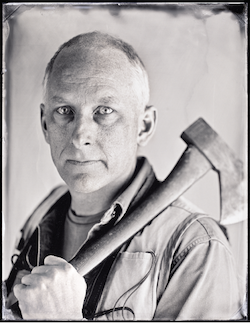Taming Sierra flames
A UC team tamps down fire danger and finds common ground
The summer of 2002 was a bad fire season in the United States. Twice as many acres burned than in 2001, and more total acres were destroyed than in all but one of the previous 40 years. The McNally Fire in Sequoia National Forest was only the second largest fire in California that year, and it alone cost more than $50 million to extinguish. It was against this smoky backdrop that George W. Bush launched the Healthy Forests Initiative, a wide-ranging plan to reduce the severity of western wildfires.
In California, the plan coalesced around the concept of strategically placed landscape treatments, colorfully shortened to SPLATs. Mark Finney, a researcher at the Missoula Fire Lab in Montana, proposed that instead of thinning entire old growth forests, land managers could “treat” a fraction of the land with tree thinning and prescribed burns. These treated plots would slow a fire's rate of spread, acting like speed bumps along a road.
It was an interesting but untested idea, and by 2004 the plan ran into bureaucratic roadblocks. Because, while the federal government owns the national forests, the old-growth dwelling wildlife — fishers, goshawks, spotted owls — can fall under state or federal management, depending on the species. Closer to the action, the local communities of Foresthill and Oakhurst were concerned about large-diameter trees being cut as part of the thinning effort, and about the effect of prescribed burning on issues like home safety, wildlife and water quality.
It was beginning to look like then-Governor Arnold Schwarzenegger, a Republican and a self-professed environmentalist, was going to sue the Bush administration over its forest policy mandates — an expensive, bitter process that nobody relished. Instead, a novel approach was conceived: The U.S. Forest Service agreed to test the unproven SPLAT approach along with state agencies, like Fish and Game, Department of Water Resources, and Cal Fire, as long as a neutral third party could be tasked with analyzing the results. And that third party would be the University of California.
And thus, the Sierra Nevada Adaptive Management Project was born, with another endearing acronym, SNAMP. Today, as SNAMP reaches the end of a 10-year run, the project has proven to be a multidisciplinary, multiagency, multimedia success that has the potential to transform not only how we view forest fires, but more intriguingly, how scientists, government agencies, and public stakeholders interact in the pursuit of common goals.
Gradually, a plan took shape. With the ultimate goal of moderating fire behavior, the U.S. Forest Service would conduct prescribed burning and tree thinning as they saw fit. It would then be up to UC scientists to study the results — not just in terms of fire, but also the impact on wildlife, water and forest health.
Working with stakeholders
Modern adaptive management takes into account complex factors — climate change, human impact, a century of fire suppression, marijuana farms on federal lands — requiring forest managers to continually adapt their strategies to new information, new methods, and new facts on the ground. Even so, a traditional study of various fire treatments would have been fairly straightforward: Do a range of experiments, analyze the results, publish some papers.
But SNAMP's goals went far beyond simply figuring out the best way to slow a wildfire's spread. The experiment proceeded along parallel tracks, studying fire, forest health, fishers, owls, water quality issues and spatial data. And crucially, public participation wasn't an afterthought or an also-ran, but the key piece of the puzzle. According to Kim Rodrigues, a UC Cooperative Extension regional director at the time, “The overall goals of public participation are efforts to reduce conflicts around resource management on the ground.” Rodrigues focused on figuring out how to make public participation more meaningful and relevant.
How to best engage the public was an open question. The team eventually settled on a simple strategy: try everything. Kelly and others created a comprehensive, interactive website stuffed with videos, summaries of scientific findings, and a huge trove of documents available for scientists, agency employees, and any member of the general public who took an interest. Perhaps the best feature was the discussion section, where people submitted questions about topics as varied as fuel break maintenance, government intrusion onto private lands, and the affects of the Native American practice of gathering pine roots. The questions received thorough responses from the team members, a level of public engagement that's truly unusual for scientists who are more accustomed to responding only to peer reviewers.
The website was moderately successful. “But our stakeholders really prefer face to face,” says Kelly, so her team ramped up its in-person efforts. Extension agents who lived in the affected communities of Oakdale and Auburn made themselves available for public questions and concerns at board of supervisors meetings, PTA gatherings, and fire-safe councils. Beyond the standard bad-coffee talkathons, the scientists also held field trips to show these theoretical issues in action.
“Anyone can talk about ‘resilient forests,'” Rodrigues says, “but if you go to the Rim Fire [the massive 2013 Yosemite blaze] you can operationalize these terms. You can show someone that this is how a high-severity fire sterilizes the soil.” And the learning went both ways, according to Lynn Huntsinger, professor in the Department of ESPM at Berkeley, who was recruited by Battles for her experience working with landowners. “I've seen management programs in the past where scientists don't come to meetings and face stakeholders,” she says. “But in this case, the stakeholders ended up influencing the kinds of research questions that the scientists asked.”
Adapted from an article Breakthroughs Magazine. Read the complete story in here.
Tintype photography by Michael Shindler



